Ingrid Ukstins Peate
Research
page maintained by
Ingrid Peate © 2011
Current Research Projects
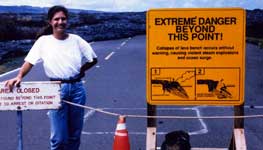
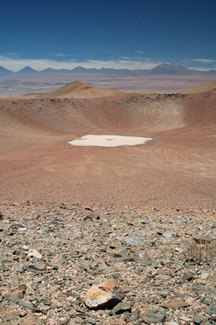 Monturaqui Impact Crater, Chile.
Monturaqui Impact Crater, Chile.The Planetary Spherules Project
The Planetary Spherules Project is funded by NASA's Planetary Geology & Geophysics research initiative (PI Nathalie Cabrol: SETICSC/NASA Ames), to study Earth-based analogues of Martian 'blueberries' in order to better constrain their formation mechanisms. On Mars, Opportunity found hematite spherules at Meridiani Planum, while recently the rover Spirit found silica-rich deposits and spherules at Gusev Crater. Formation mechanisms for the Martian blueberries are still debated, but may involve aqueous, volcanic or meteorite impact processes. We have identified several sites in the Atacama Desert, Chile, which have spherules that are morphologically similar to Martian blueberries, and represent the different formation mechanisms proposed for Martian sites. Our objective is to characterize the geological context, formation, emplacement mechanisms, and evolution of spherule-bearing deposits in the Atacama Desert in order to better constrain the origins of Martian blueberries. Our current localities include: 1. Monturaqui Impact Crater - a young (ca. 1 Ma) meteorite impact crater on the Altiplano, approximately 400 m in diameter, which has metallic spherules in impact glass. These spherules are thought to form by melting a metallic meteorite. 2. Salar Grande - Jurassic volcanic rocks adjacent to a Miocene salt flat, with silica-rich spherules that are related to volcanic hydrothermal activity. 3. Guanaco - Devonian to Oligocene sedimentary and volcanic rocks with volcanically derived spherules.
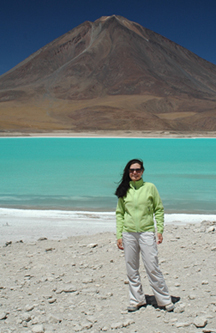 Licancabur and Laguna Blanca, Bolivia.
Licancabur and Laguna Blanca, Bolivia.
The High Lakes Project
The High Lakes Project is funded by the NASA Astrobiology Institute and headed by Dr. Nathalie Cabrol of NASA SETI. This project explores life in extreme environments, in the lakes of the Chilean and Bolivian Andes. These lakes are among the highest-altitude on the planet (from ca. 4,500 to 6000 m), and experience large temperature variations, extremely high levels of UV radiation, and host unique ecosystems. This environment is a good approximation for what we think conditions were like on early Mars when life may have developed there. The goals of this project are to understand the physical, chemical, geological, and climate constraints on habitability in these high altitude lakes, and develop models for their analogy to ancient Mars in order to understand the potential for life there. High lake exploration provides unique knowledge about the biosphere of Earth, the origin and evolution of life, and its adaptation to rapid climate change in extreme environments.
My role in this project is as a volcanologist and geochemist. These lakes exist on the flanks and in the summit craters of active volcanoes, and are constantly impacted by the volcanic activity of their host. In order to fully understand how life exists in these lakes, we need to quantify their temporal history and the impact of volcanic eruptions. I study the type, and timing, of volcanic eruptions in order to determine their effect on lake ecosystems.
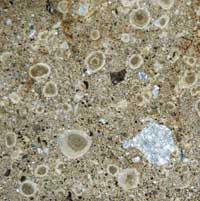 Accretionary lapilli, Emeishan large igneous province, China.
Accretionary lapilli, Emeishan large igneous province, China.
 Banded shard, Afro-Arabian flood basalt province.
Banded shard, Afro-Arabian flood basalt province.
Pyroclastic volcanism in Flood Basalt Provinces
Mafic pyroclastic deposits
Mafic pyroclastic and reworked epiclastic deposits (MVDs: mafic volcaniclastic deposits) have recently come to be recognized as a volumetrically and volcanostratigraphically integral part of flood basalt provinces (Ross et al. 2005). They provide key constraints on eruption, emplacement and depositional environment often not discernable from studying the effusive volcanic component alone, and pyroclastic eruptions have the potential to rapidly inject copious quantities of particulates and aerosols directly into the upper atmosphere, potentially causing a more forceful climate impact than passive degassing of lava flows. I have conducted research on MVDs from a variety of flood basalt provinces (East Grenland: North Atlantic Large Igneous Province; Yemen & Ethiopia: Afro-Arabian Flood Basalt Province), and most recently initiated a project on the Emeishan Large Igneous Province (China) studying a voluminous sequence of MVDs in the lower part of the volcanic stratigraphy, which was erupted through a shallow-level carbonate platform. The detailed volcanic stratigraphy preserved in the lower Emeishan provides information on eruption and emplacement mechanisms, and depositional environmental changes, during the initial phases of a flood basalt province, and may provide new insight into models of dynamic uplift during mantle plume impact as well as climate impact of flood basalt events.
Silicic pyroclastic deposits
Large Igneous Provinces (LIPs) and flood basalts, while dominated by basaltic volcanic products, may also contain a volumerically significant component of silicic volcanism. Afro-Arabia is prime example of a bimodal flood basalt province, with approximately 20 per cent by volume of silicic pyroclastic material (Ukstins Peate et al. 2005). These may be among the largest eruption events currently known, containing thousands of cubic kilometers of ash and forming tephra layers 10's of cm thick in the Indian Ocean 3000 km from the source vent. These are also some of the most heretogeneous individual eruptions yet documented, with silica variations of >20 % within individual ash layers. My continuing research on these deposits focuses on understanding the petrogenesis and climate impact of such large-volume, heterogeneous eruption events, and utilizes both traditional geochronology, petrology and geochemistry as well as microanalytical techniques such as melt inclusion studies and in-situ major, trace element and isotopic analysis of individual shards.
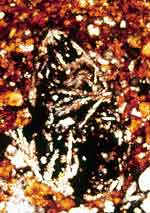 Pele's tear, Haengefjeldet Fm., East Greenland LIP
Pele's tear, Haengefjeldet Fm., East Greenland LIP
Origins and volatile budgets of flood basalt eruptions
Large igneous provinces represent the most voluminous outpourings of lava on the Earth's surface, and are characterized by rapid eruption (ca. 1 Ma) of dominantly tholeiitic magma. They are thought to originate from thermo-chemical anomalies (or plumes) originating from the mantle or core-mantle boundary, but other mechanisms of generation such as edge convection at lithspoheric discontinuities have been proposed and chemical anomalies have been attributed to melting of distinct compositional reservoirs such as continental lithospheric mantle or recycled fertile eclogite. During magma generation, storage, and transport in the crust, assimilation can cam significantly modify mantle-derived melts, leading to complications in interpretation of lava compositions. Due to their immense volumes and volatile fluxes, flood basalts have been linked to episodes of global climate change and many researchers have speculated on the nature and timing of their climate impact. New research on pyroclastic volcanism in flood basalt provinces, both mafic and silicic, has the potential to significantly influence this field of inquiry, as explosive eruptions can directly inject ash and gas 10's of km into the atmosphere, enhancing the global impact of any such event.
NSF-funded research with David Peate (U of I) and Adam Kent (Oregon State University) focuses on addressing the question of climate impact of flood basalt eruptions by studying olivine-, plagioclase- and pyroxene-hosted melt inclusions in primitive flood basalts from a variety of provinces (Ferrar, Paraná-Etendeka, West Greenland - North Atlantic Large Igneous Province, Afro-Arabia, and Siberian Traps) to investigate crustal assimilation, melt generation and mixing processes, and to constrain primary volatile contents (S, Cl, water) of lavas. A complimentary research project focuses on melt inclusions from 30+ Ma of Afro-Arabian silicic pyroclastic eruptions in an effort to constrain mechanisms of generation and global-scale climate impact of voluminous silicic pyroclastic eruptions.
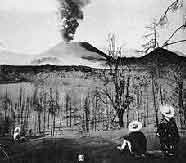 Paricutin, March 1944. Foshag and Gonzalez-Reyna (1956).
Paricutin, March 1944. Foshag and Gonzalez-Reyna (1956).
Rates and mechanisms of crustal assimilation
Compositional heterogeneity in monogenetic eruptions from small-volume basaltic volcanic fields provides an opportunity to understand how compositions of continental basaltic magma are influenced by assimilation of crustal materials they encounter prior to and during eruption. An NSF-funded project with David Peate examines individual monogenetic eruptions of the Ice Springs basaltic lava flow (c. 1290 AD, Utah) and Paricutin Volcano (1943-1952 AD, Mexico), both young (>1000 years old) and preserving compositional variations attributed to crustal assimilation and fractional crystallization. We will use a variety of techniques to examine geochemical heterogeneity over a range of lengthscales (lava field, flow lobes, whole rock samples and melt inclusions), including detailed in situ melt inclusions analyses, U-series disequilibria and high-precision Pb isotopes. In combination, these efforts will provide a new approach to understanding the mechanisms and rates of crustal assimilation and fractionation processes.
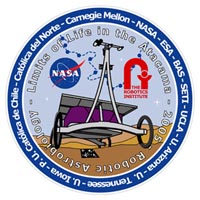 Zoe, designed by Carnegie Mellon Robotics Institute.
Zoe, designed by Carnegie Mellon Robotics Institute.
Evaluating the efficacy of remote geologic exploration
The scientific success of a remote exploration rover mission depends on the right combination of technology, teamwork and scientific insight. In order to quantitatively evaluate the success of a rover field trial, it is necessary to assess the accuracy of scientific interpretations made during the field test. An Obermann Fellowship in 2006 allowed me, Geb Thomas (Mechanical and Industrial Engineering, U of I) and Mark Reagan (Geology, U of I) to explore the mechanisms of evaluating remotely derived geologic interpretation from the LITA Project (Life in the Atacama). How to measure the 'correctness' of a geologic observation or interpretation is particularly challenging both because of the complexity of geologic interpretations (Baker 1999; Frodeman 1995), as well as the lack of overreaching constraints provided by geologists operating in open systems. We gained insight into this issue by delving into the philosophy of geology as a science and the evaluation of geologic reasoning (e.g., Schumm 1991; Frodeman 1995; Baker 1999), as well as the semiotics of geology and how our personal scientific backgrounds and group interactions inform and modify our observations, interpretations and working methodology.
A continuation of this project involves constructing testable databases simulating rover-derived data in an easily-accessible, web-based forum which will allow us to independently modify individual variables of interest (eg. photographic image resolution, orbital images, VNIR spectral data) and observe the effects on the quality and consistency of geologic interpretations derived from them. This project, when completed, is designed to be broadly utilized in geologic education as a stand-alone web module in lab classes and on-line, allowing students and interested individuals to be planetary geologists and interpret images and data as if they were participating in an astrogeology exploration mission.
Graduate Student and Post-Doctoral Research Projects & Committees
Matthew Jefferson M.S., in progress. Geoscience Department, University of Iowa: advisor.
Maija Sipola Ph. D., in progress. Geoscience Department, University of Iowa: thesis committee.
Meredith Petrie Ph. D., in progress. Geoscience Department, University of Iowa: thesis committee.
Jaime Ricci M.S., in progress. Geoscience Department, University of Iowa: thesis committee.
Shawn Malone Ph. D., in progress. Geoscience Department, University of Iowa: thesis committee.
Christy Kloberdanz M.S., 2010. Geoscience Department, University of Iowa: advisor.
Lee Falkena M.S., 2009. Geoscience Department, University of Iowa: co-advisor.
Jay Thompson M.S., 2009. Geoscience Department, University of Iowa: thesis committee.
Ryan Clark M.S., 2006. Geoscience Department, University of Iowa: thesis committee.
Jamie Nakamoto M.S., 2006. Mechanical and Industrial Engineering, University of Iowa: thesis committee.
Representative Undergraduate Student Research Projects
Sarah Byram (2008-2009) *
Senionr honors thesis.
Funded through an IREU award.Kelli Parsons (2008-2009) *
Funded through a NASA Education and Public Outreach grant: Planetary Spherules Project.Deanna Dietz (2008) *
Funded through a NASA Education and Public Outreach grant: Planetary Spherules Project.Jamie Marie Parker (2006-2007) * #
Senior honors thesis: Pyroclastic deposits of the Emeishan Large Igneous Province, China.Amanda Parker (2007) * #
Senior honors thesis: Amphibole reaction rims as a record of magma ascent, Yemen.Jessica Bruse (2005-2007) *
Mineral compositional variations in the Tabernacle Hill flow, Utah.
Partly funded through a North-Central GSA Undergraduate research grant.Shane Behanish (2005-2006)
Olivine-hosted melt inclusions from Vaigat Formation flood basalts, West Greenland.
Funded through an NSF research grant.* indicates female student
# indicates minority student
Field Experience
Blosseville Kyst, East Greenland (M.Sc. research, June-July 1995).
Iceland (Nordic Volcanological Institute conference on mid-ocean ridges, August 1997).
Poleta Folds, Deep Springs Valley, CA, USA (Instructor, Field Camp, June 1998).
Yemen (Ph.D. research, November 1999).
Ethiopia (Ph.D. research, December 1999).
Albuquerque Volcanic Field & Valles Caldera, NM, USA (Field course, March 2004).
Death Valley, CA, USA (Instructor, Spring Break Field Trip, March 2005).
Joshua Tree National Park and Mojave National Preserve, CA, USA (Instructor, Spring Break Field Trip, March 2006).
Atacama Desert, Antofagasta, Chile: Mars rover research (November 2005, January 2006).
Emeishan Province, China (IAVCEI field trip and mafic volcaniclastic deposits research, May 2006).
Nanjing & Beijing, China (Instructor, Spring Break Field Trip, March 2007, 2011).
Dillon, MT, USA (Instructor, Field Methods, May 2004, 2005, 2007, 2010).
Park City, UT, USA (Instructor, Wasatch-Uinta Field Camp, June-July 2004-2009).
Faroe Islands (1st Johannes Rasmussen Conference, August 2007).
Chilean Andes and Altiplano: High Lakes Project, Planetary Spherules Project (October-December 2007, 2008).

